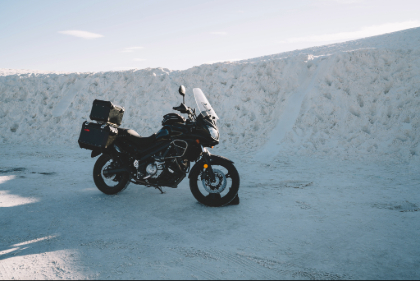INDEPENDENT DEALER
Clermont, FL | (918) 269-0081
OUR BLOG
Looking for a quick and simple motorcycle winterization guide? This post from K&K Oils and Lube in Clermont, FL, has you covered with expert storage advice.

Ever try starting your bike after winter, only to hear silence or weak cranking? You can avoid this by preparing it properly. Winterizing your rig is simple if you know what to do. Follow our motorcycle winterization guide to keep your bike in top shape. Protect the battery, stabilize the fuel, and cover key parts to prevent cold-weather damage. A small effort now means an easy start when spring arrives. Be ready to ride as soon as the warm weather returns!
Need battery maintenance supplies or expert advice? Don't let a dead battery ruin your spring riding plans. Contact K&K Oils and Lube in Clermont, FL at (918) 269-0081 for quality car care supplies. Want quick and easy shopping? AMSOIL’s e-store is just a click away, 24/7!
Step 1: Give Your Fuel System Some Love
Here's the deal: gasoline is basically motorcycle poison when it sits around too long. It turns into a gummy mess that clogs your fuel system faster than you can say "expensive repair bill."
What you need to do: Fill your tank completely (this prevents moisture buildup) and add a high-quality fuel stabilizer. Don't just pour it in and call it good; run your bike for about 10 minutes so the treated fuel gets through the entire system. Think of it as giving your fuel lines a protective coating for the winter.
Step 2: Master Your Motorcycle Battery Maintenance Tips
Your bike's battery is probably the most vulnerable part during storage. Cold weather is tough on batteries, and letting them sit without proper care is like leaving money on the table.
The smart approach: Remove your battery and bring it inside to a cool, dry spot (but not freezing!). Clean those terminals until they shine, then give them a thin coat of petroleum jelly to stop corrosion in its tracks.
Here's a pro tip: invest in a battery tender. These little devices keep your battery at the perfect charge level all winter long. No more dead batteries come spring! If you're keeping the battery in the bike, at least disconnect it (negative terminal first, then positive).
Step 3: Change That Oil (Yes, Even for Storage!)
This might seem backward, but hear us out. Used oil is full of nasty contaminants and acids that love to attack your engine parts while you're not looking. It's like leaving dirty dishes in the sink for months: things get gross fast.
Do this: Change both your oil and filter before storage. AMSOIL synthetic motorcycle oil is perfect here because it maintains its protective properties even during long storage periods. Your engine will thank you when spring rolls around.
Ready to upgrade your oil? K&K Oils and Lube offers AMSOIL 5W-40 100% Synthetic Metric Motorcycle Oil, providing top protection for your bike during storage and beyond. Call them at (918) 269-0081 to get premium oil in Clermont, FL, or browse AMSOIL products online anytime.
Step 4: Follow This Winter Motorcycle Storage Checklist
Let's talk tires first. Inflate them to the maximum recommended pressure because they'll naturally lose air over time. If you can get your bike up on stands, do it! This takes weight off the tires and prevents those annoying flat spots.
For your cooling system: Check the coolant level and give it a sniff test. If it looks funky or is due for replacement, handle that now. Good coolant doesn't just prevent freezing; it fights corrosion, too.
Exterior protection: Give your bike a thorough wash and dry, then apply a good coat of wax. Treat leather seats with conditioner, and put a light coat of oil on chrome parts. Think of it as tucking your bike in for a long winter's nap.
Step 5: Choose the Right Cover and Storage Spot
Plastic tarps are your enemy here. They trap moisture and turn your storage area into a mini greenhouse for rust. Instead, use a breathable motorcycle cover that keeps dust out while letting moisture escape.
Location matters: A dry, well-ventilated space is ideal. If you're storing on concrete, lay down a tarp or cardboard first because concrete loves to wick up moisture, and your bike doesn't need that drama.
Spring Will Come (And So Will Riding Season!)
Keep a simple checklist of your actions so you'll know exactly what to reverse when it's time to ride again. Reinstall that battery, check fluid levels, and inspect those tires, and you'll be ready to roll.
Ready to Winterize Like a Pro?
Don't gamble with your bike's health this winter. Following this motorcycle winterization guide protects your investment and ensures many more seasons of reliable riding.